Borthwick Institute for Archives
- Borthwick Institute home
- Visiting us
- Collections
- Services
- Exhibitions
- Projects
- Online Resources
- Publications
- Contact us
- Teaching and Learning
- About the Borthwick
- Records Management
Lesbian, Gay, Bisexual & Transgender history
Introduction
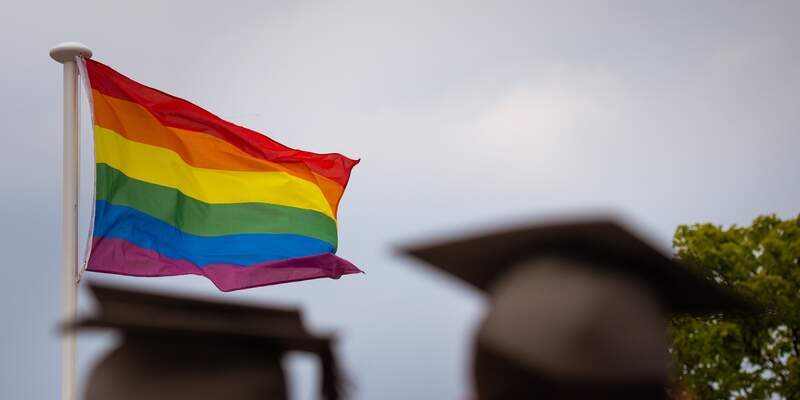 Studying the history of sexuality and gender identity can be difficult. Many of the terms we use today to describe Lesbian, Gay, Bisexual and Transgender people only appeared for the first time in the nineteenth, twentieth and twenty-first centuries. Homosexuality was illegal in England and Wales until 1967, but lesbian relationships were not officially criminalised. This can make it harder to find concrete evidence of lesbian relationships, whereas a lot of evidence of homosexuality comes from criminal records (which are not held at the Borthwick Institute). In addition, religious and cultural attitudes towards sexuality and gender identity often limited the extent to which such things could be openly discussed and explored, using ambiguous or critical language and imagery. As such this is a history that is rapidly developing with new sources and stories to discover.
Studying the history of sexuality and gender identity can be difficult. Many of the terms we use today to describe Lesbian, Gay, Bisexual and Transgender people only appeared for the first time in the nineteenth, twentieth and twenty-first centuries. Homosexuality was illegal in England and Wales until 1967, but lesbian relationships were not officially criminalised. This can make it harder to find concrete evidence of lesbian relationships, whereas a lot of evidence of homosexuality comes from criminal records (which are not held at the Borthwick Institute). In addition, religious and cultural attitudes towards sexuality and gender identity often limited the extent to which such things could be openly discussed and explored, using ambiguous or critical language and imagery. As such this is a history that is rapidly developing with new sources and stories to discover.
In a recent talk at the University of York as part of the Celebrating Diversity events series, in conjunction with LGBT+ History Month 2023, writer and historian Dr Kit Heyam addressed some of the complexities of researching trans history. You can find out more in the video below.
This introductory research guide aims to uncover some of this hidden history, particularly within the records held at the Borthwick. It describes some of the main collections of documents which may include relevant material. To illustrate this, you can also read the stories of three LGBTQ+ individuals - Anne Lister, Barbara Hill and Edward Hewitson - and view documents relevant to their stories. These case studies demonstrate how the story of individuals can be pieced together from different sources at the Borthwick, together with material from other archives. None of these case histories are complete and we would welcome any suggestions or new insights into the stories they tell, as well as new stories. Suggestions of records which may help are given.
A general introductory guide, including terminology, background information and key government record sets for studying sexuality and gender identity history can also be found on The National Archives (UK) website.
The Church

Institutional attitudes towards sexuality and gender identity are an important area of study. Amongst the Borthwick's holdings, the records of the established Church, both before and after the Reformation, give information about its attitudes towards sexual behaviour and gender conformity. Until the mid-nineteenth century, the Church had a series of courts in each diocese, hearing cases on a variety of subjects. These included charges against people accused of sodomy, a word which had a number of meanings (at least until the eighteenth century) but could include accusations of sexual relations with members of the same sex. Records of these cases do not often survive in ecclesiastical archives. The earliest known survival in England is a fourteenth century case amongst the records of the secular court of the Corporation of London concerning a male sex worker called John Rykener who ‘dressed up as a woman’. A full transcription of Rykener's case is available online and names a number of other people, men and women, who knew of, or assisted Rykener.
Among the court records of the Diocese of York, a notable case of this kind is that of Edward Hewitson of Over Poppleton, near York, who was accused of engaging in homosexual behaviour with other men over a period of fourteen years in 1516-1517. More details about the Hewitson case can be found here. An even earlier case, which has yet to be studied, can be found in the register of William Melton, Archbishop of York. In 1321 Thomas, Rector of Lowthorpe, was brought up on the charge of ‘sodomy’ with Roger Pell of Hedon. The digitisation of the York archbishops’ registers, and our recent indexing projects, demonstrate how new information can be found even in our oldest records, bringing to light cases and individuals that might have previously been overlooked.
Homosexuality has increasingly become an area for discussion in the Church of England. Debates can be followed in the General Synod's papers and reports (including their papers on human sexuality): the annual summer meeting of the synod is held in York and copies of many of these papers are in the Borthwick. The correspondence of individual bishops and clergymen may also prove to include discussion of such issues. The Borthwick also holds the records of members of Church of England communities with particular concerns with contemporary theology and pastoral issues, such as the Community of the Resurrection at Mirfield and the Society of the Sacred Mission at Kelham.
Collections highlights
The database contains digitised images of the registers of the Archbishops of York between 1225 and 1650. The registers from 1304 to 1405, and from 1576 to 1650 have been indexed.
Cause Papers in the Diocesan Courts of the Archbishopric of York
This database includes a searchable catalogue of more than 14,000 cause papers relating to cases heard in the Diocesan Courts of the Archbishopric of York between 1300 and 1858.
Community of the Resurrection at Mirfield
The Community of the Resurrection was established in 1892 as an Anglican religious order for men. Brethren of the Community follow a daily routine of prayer and worship and engage in pastoral, evangelistic, educational and other charitable works for the advancement of religion in the UK and abroad. Five of the six founding members were members of the Christian Social Union, a group dedicated to the remedying of poverty and social injustice, and the Community has retained a strong commitment to social action.
Society of the Sacred Mission at Kelham
The Society of the Sacred Mission (SSM) is an Anglican religious order founded by Father Herbert Hamilton Kelly in 1893. Key to the work of the Society was the recruitment of men from poorer backgrounds who would not normally have the means to train for ordination through the usual route of university and theological college.
The University
LGBTQ+ voices on campus
The University of York has been a platform for LGBTQ+ voices since the early 1970s, and the student press of the period can provide quite a significant insight into the lives and activities of LGBTQ+ youth, both on campus and on a wider scale in York.
Nouse, the oldest and the main campus newspaper, included a small advert in November 1970 calling for homosexuals to join the new discussion group that was being organised by the Committee for Homosexual Equality. This marked the birth of the first LGBTQ+ society on campus. Immediately, the newly-formed student group was criticised for spreading indecency and had to operate in terms of secrecy and anonymity – the founders of the group could not take the risk, as homosexual relationships between men had only been decriminalised in 1967.
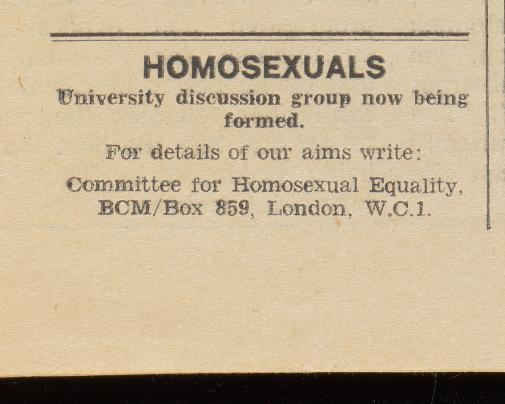
The student newspapers of the time record a community that was slowly battling towards openness and acceptance, despite criticism. In 1974 the GaySoc – the LGBTQ+ society at the time – was granted £100 from the Students Union, showing the University’s support for the cause of equality on campus. Despite that support, the group was frequently subjected to outright homophobic criticism. Reader’s letters from the period show that some people still considered being gay a medical issue that needed treating – perhaps a legacy of the terrible aversion therapies employed by some institutions in the 1950s and 1960s and publicised in newspapers as a breakthrough.
The University of York students and staff have always fought for equality, and LGBTQ+ rights are not an exception. Following a violent homophobic attack on campus, which left a prominent member of GaySoc injured and other members of the community questioning their safety, the response from the University came quickly. The leader of the group behind the assault was fined and suspended from the University, and had to issue a formal apology. The rest of the group were fined and warned. While the students praised the University’s handling of the incident, the issue of the continuing need to fight for LGBTQ+ rights was once again raised.
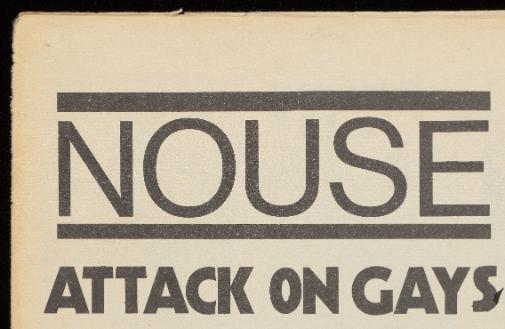
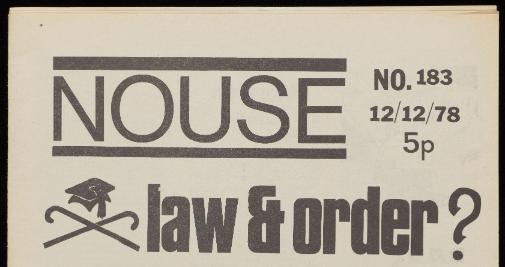
In 1988 Margaret Thatcher’s Conservative government introduced Section 28, also known as Clause 28, prohibiting the ‘promotion of homosexuality’ by local authorities. The clause, essentially banning any signs of homosexuality ‘in public’, was met with resistance around the nation. The archives show how the University’s LGBTQ+ community reacted to the changes, and their participation in protests and demonstrations against the clause, as well as how reporting about LGBTQ+ life and issues changed in the years after the law was passed. Clause 28 was eventually scrapped in England and Wales in 2003, and LGBTQ+ rights were later strengthened by the Equality Act 2010.
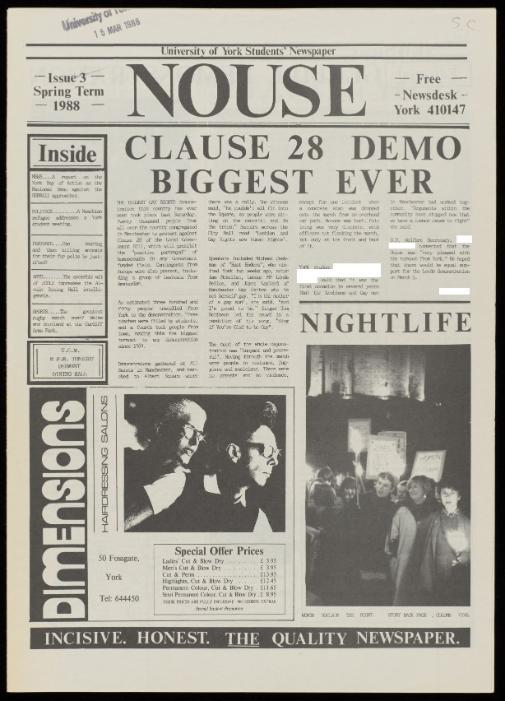
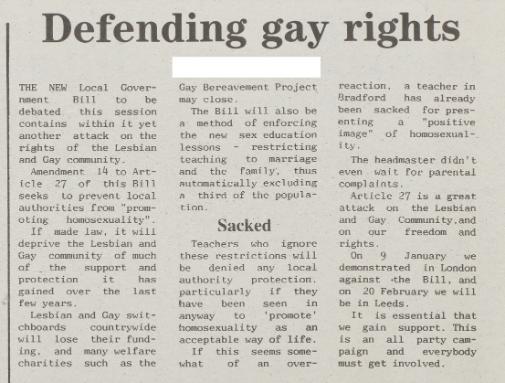
In 1981 HIV/AIDS was first diagnosed in the UK. At the time, it was seen as a disease with many myths and prejudices surrounding it, and this was not lost on the student press at University of York. Both York Vision and Nouse dedicated articles and whole two-page pull-outs to the disease, trying to break the stigma around it and informing the University’s community about how to stay safe. As early as 1985, the student press published an article which explored worrying links between sexuality and AIDS. In subsequent years, it continuously promoted information about the disease, and methods to avoid it, focusing on safe sex practices in homosexual or bisexual relationships, and sex education.
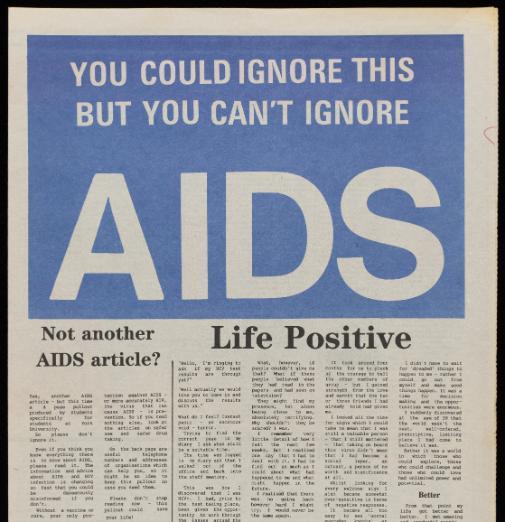
The University and Pride
The University of York has been involved in Pride for many years. Student media records dedicated ‘Pride Weeks’ as early as 1986, with the 1986 Pride disco attracting more people than initially expected (prompting the organisers from the Lesbian and Gay Society to look for another larger venue at the last minute!). Even after the passing of Clause 28, the 1991 Pride Week still went ahead, with many events featuring debates with Conservative MPs and discussions about the co-existence of homosexuality and Christianity. Later Pride Weeks included charity sales and discos in support of AIDS patients.
A notable Pride event was in 1995, when the student community was alarmed by the recent rise of homophobic attacks in the city. Combatting homophobia was a regular theme of many Pride Week events, and in 1995, there was a notable Valentine’s Day ‘kiss-in’ – encouraging homosexual couples to kiss in public to raise visibility. That Pride Week was a great success, with the ‘kiss-in’ attracting much praise and attention for making the community visible.
Campus design
The University's commitment to inclusivity was recently furthered by the announcement that two new student colleges on Campus East would be named after Anne Lister and David Kato. The official opening of Anne Lister college was held in October 2021, with both colleges fully operational by September 2022.
Anne Lister (1791-1840) was a local landowner in West Yorkshire, most famous for keeping coded diaries about her relationships with women. You can read more about here in the individuals section of this guide, or why not watch the recording of the University's York Festival of Ideas session for the opening of the college in 2021 - Gentleman Jack: The Life and Legacy of Anne Lister.
David Kato (1964-2011) was a Ugandan human rights defender and gay rights activist, who had a significant impact on the rights of LGBT+ people in Uganda. Described by The Economist as Uganda's first openly gay man, Kato used education, advocacy and activism to fight for the projection of LGBT+ peoples' fundamental rights and freedom. He was also one of the founding members of the Sexual Minorities Uganda (SMUG) advocacy group. Kato studied at University of York for six months in 2010. You can find out more about him in the University Press release on the naming of David Kato college, and read his own words on studying in York.
Collections Highlights
Nouse is a student newspaper and media outlet at the University of York. Sponsored by the York University Students’ Union, it is the university's oldest registered student society. It’s first print issue was published on 23 November 1964.
The student newspaper ‘Vision’ began in 1987 and marketed itself as being independent from the Student Union, and thereby offering an alternative to Nouse. The paper’s stated aims were to further the interests of students and to report on matters that may be of concern to them. It covered campus and local news. It was later rebranded ‘York Vision’.
Social History
It can be quite difficult to find information about the day to day lives of LGBTQ+ people in the United Kingdom. Homosexual acts between men were only decriminalised in 1967, and lesbian acts were never actually criminalised at all. As a result, outside of criminal records it can be difficult to find details of the social lives of ordinary members of the LGBTQ+ community in the 20th century.
One good source held in the Borthwick Institute, though, is the collection of case studies compiled by Seebohm Rowntree and his staff in preparation for his 1951 study English Life and Leisure. After the Second World War, Rowntree, a member of York-based chocolate-making family, and an influential figure in the development of sociology as a discipline, combined efforts with his long-term research assistant G. R. Lavers, sociologist Ferdinand Zweig, and Miss M. E. Walker, to produce English Life and Leisure.
By modern standards, the interview techniques employed in the study do pose ethical issues, as no direct consent was obtained from the participants. The team employed an ‘indirect interviewing’ technique – the investigators would get to know their ‘subjects’ in an informal atmosphere, stopping the acquaintance as they got the information they needed. This way, they felt, they would get more candid and frank responses than if they held formal interviews. In many respects, this has proved to be the case. You can find out more information about the background to the study and the techniques used in our introductory film:
Furthermore, Seebohm Rowntree and G. R. Lavers were men from wealthy backgrounds, and both were white. Rowntree was also a Quaker, with a passionate belief in the spiritual value of religion. Whilst most of the cases deal with fairly regular people from a wide range of backgrounds – who may be married or not, may smoke or drink or bet on dog races – one of the interview topics concerned sexual activity. Various responses were given to this question – some people commented how they would not have sex before marriage, some expected their future wife not to have sexual contacts before marriage, and some were gay, opening up about it in a casual conversation with the investigator, despite homosexual relationships still being criminalised. These attitudes were also reflected in the book.
It can sometimes be unhelpful to apply modern terminology to historical cases, as we aren't always sure that the terms we are using are ones that the person in the past would have recognised themselves. One of the Rowntree cases, though, appears to be a woman we would now consider to be asexual. Unlike a similar case study where a woman speaks of her desire not to have sex as she is scared of complications in childbirth (her close relative died in labour), for Miss S. the physical side of a relationship is repugnant, and she shuns marriage on this account. The young woman interviewed was from a well-off family and had a good education, but had turned to petty crime and spent several years in correctional facilities. At the time of the interview, though, she was living a normal and independent life. It's almost hard to believe that someone in 1948 would be this open about her sexuality.
Other case studies for the book feature a retired colonel, who despite being aged seventy-five is gay, quite open about it and likes ‘well-built young men’; an architect, who quite openly confesses he lives on money that his boyfriend gives him; and a curious case of a former Flight-Lieutenant. The former Flight-Lieutenant, Mr. C, is a good-looking commercial traveller, and is described as ‘sexually unusual for he is strongly and actively homosexual, but in addition indulges into normal sexual activities. He is engaged to a girl of twenty-five, who appeared ... very charming. She is trying to reform him, and will not marry him until he has given up his homosexual practices of which he told her.’ Mr. C is potentially bisexual. Interestingly, Mr. C is expecting his fiancée not to engage in any sexual activity before marriage, being quite traditional in his mindset, despite himself engaging in sexual relationships with both men and women.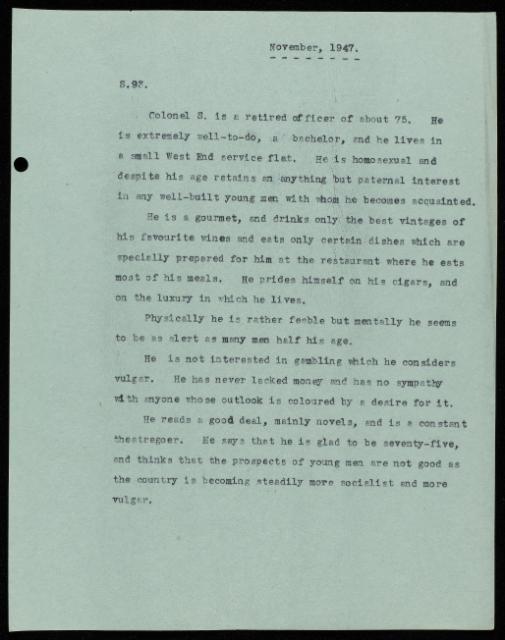
Collections Highlights
These 700 case histories, conducted by G. R. Lavers, Ferdinand Zweig and Miss Walker during 1947 and 1948 for Seebohm Rowntree’s 1951 book English Life and Leisure, include a small number of anonymised case studies of people who describe themselves as LGBTQ+.
Further Reading
‘Bringing the Rowntree Leisure Time Interviews to Life’ online exhibition on the Borthwick website.
Rowntree, Benjamin Seebohm and Lavers, G.R, English Life and Leisure: a social study, (London: Longmans, 1951).
Finding Individuals
LGBTQ+ history frequently makes use of biographical case-studies. Standard sources should not be overlooked when piecing together LGBTQ+ biographies: it is always worth looking at family letters and papers, records of baptisms, marriages and burials and probate records. At the Borthwick we hold wills for the majority of Yorkshire up to 1858, as well as some wills of those from other parts of northern England, and parish records for the city of York and approximately twenty miles round. We also hold some relevant microfilms of diaries. These resources enable us to provide information about famous women identified as lesbians such as Eleanor Butler and Sarah Ponsonby, known as The Ladies of Llangollen, whose diaries are on microfilm, and Anne Lister of Shibden Hall in Halifax. Anne Lister's case study shows that whilst the bulk of the Lister family records are held by the West Yorkshire Archive Service there is also important biographical material about Anne and her partners at the Borthwick.
We also hold the archives of other famous people who identified as LGBTQ+, but where their sexuality is not necessarily addressed in the archives we hold. A good example of this is the comedian and actor Frankie Howerd. Howerd was born in York and was gay, but in his professional archive, which we acquired in 2021, there is almost nothing about his sexuality. The extensive archive of scripts, correspondence, contracts, photographs, fan mail and audio visual material hasn't yet been fully explored, though, so more information may come to light in future. 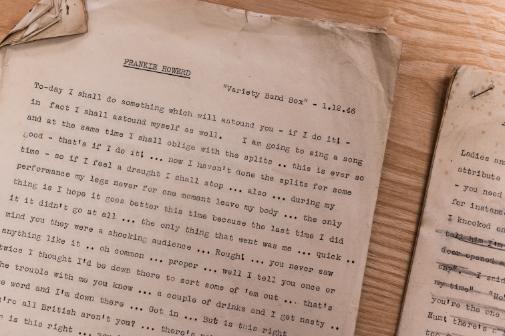
The archives can also shed light on the stories of other, less famous men and women. An intriguing example of this is the case of Barbara Hill, who in 1757 married Ann Steel at Bolton Percy, near York, under the name of John Brown. The marriage took place without controversy but later a note had been added, stating that Brown was ‘afterwards discovered to be a woman dressed in man's apparel and of course separated from the said Ann Steel’. A full discussion of the Barbara Hill case can be read at this link. It demonstrates how parish records can be combined with other contemporary sources to add depth and context to such an unusual register entry, and raises the question of what other, similar stories are still waiting to be found.
Collections Highlights
Will of Anne Lister of Shibden Hall, written May 1836 (Ref: Prog. May 1841).
Copy of the will of Ann Walker of Shibden Hall, written May 1841 (Ref: Prog. May 1854).
Further Reading
A Brief Guide to sources for Genealogy and Family History at the Borthwick Institute
Are you looking for a will?
Medical records
Attitudes of the medical establishment towards sexuality and gender identity have yet to be fully explored. The records of the York psychiatric hospitals at Bootham and Clifton and the private psychiatric hospital The Retreat include extensive patients' case records and admissions registers from the late eighteenth century onwards. Same-sex attraction or aversion to marriage, for example, could be interpreted as mental illness, and those who might in modern terms be described as LGTBQ+ were subject to mental health treatment. A study of these may well reveal patients whose problems relate to their sexuality or gender identity (particularly amongst women diagnosed as nymphomaniacs or as frigid) and provide information about how doctors saw and treated these patients and whether attitudes changed over time.
Please note that data protection legislation restricts access to records less than 100 years old and researchers wishing to use twentieth century medical records should contact the Borthwick for further information.
Further Reading
Dickinson, Tommy, ‘Curing Queers’: Mental Nurses And Their Patients, 1935-74 (Manchester, Manchester University Press, 2016)
Borthwick Institute for Archives
University of York,
Heslington,
York,
YO10 5DD,
UK
Tel:
work
01904 321166
|
borthwick-institute@york.ac.uk

Legal statements | Privacy | Cookies | Accessibility
© University of York | Modify | Direct Edit
